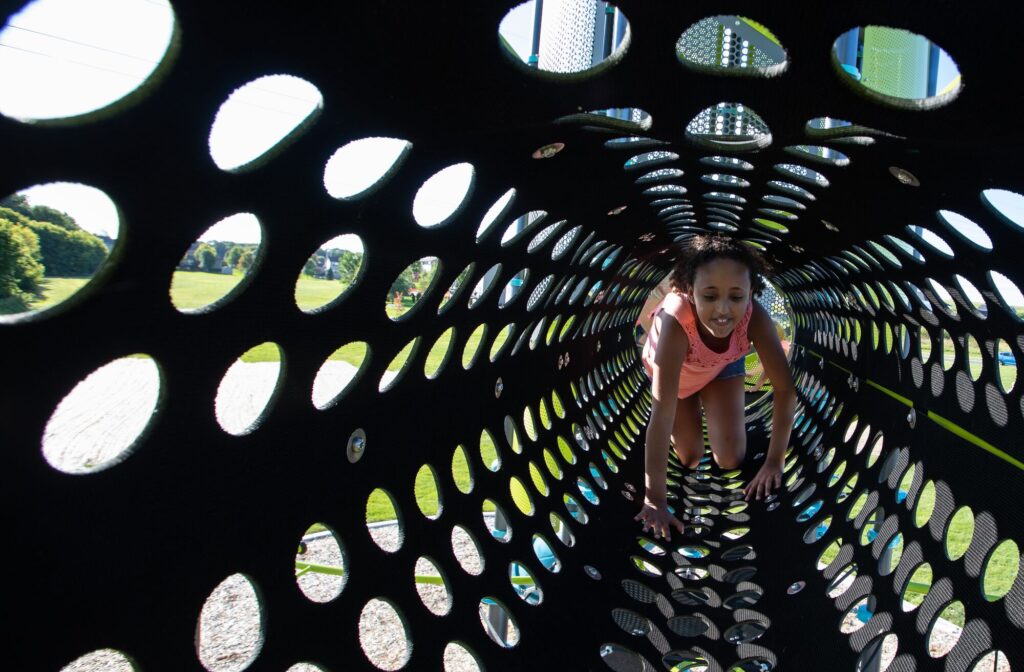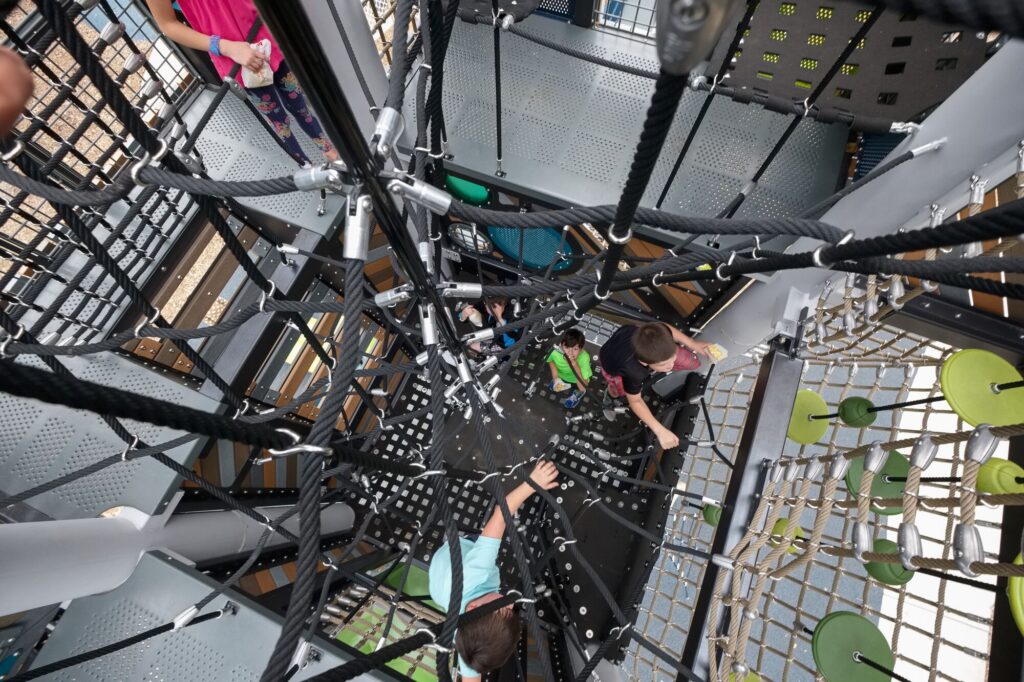The Importance of Risky Play

Written by Sonya Wilson
Why Too Much Safety Can Put Kids at Risk
Helen Keller wrote in The Open Door, “Avoiding danger is no safer in the long run than outright exposure. Life is either a daring adventure or nothing at all.”
Children know this to be true every time they experience unstructured play outside, engaging in what is known as risky play. Through climbing higher. Accelerating to new speeds. Exploring farther from home or building a fort out of old lumber and found objects.
Let’s try to re-imagine the concept of risk in play. To see it through a different lens. To understand (if children are inevitably going to push boundaries in their play) that we must be ready to meet them in the park with play spaces that offer the potential of risk.
What is risky play and why is it beneficial?
How do you balance safety and risk?
And how do you create play spaces where kids can challenge their limits?
What is Risky Play?
Risky play can generally be defined as thrilling and exciting forms of play that involve a risk of physical injury or unknown outcome. It happens when kids push themselves to test their own limits when given the opportunity for unstructured play.
Some Factors of Risky Play
- Height
- High speeds
- Playing near elements (water, fire, a hole)
- The chance of getting lost
- Rough and tumble play
The most important thing to remember here is the notion of perceived risk. Children are actually really good at subjective risk perception. Parachute, Canada’s national charity dedicated to injury prevention, points out that as children move through developmental milestones, their idea of risk changes. What a 3-year-old perceives as risky, like reaching for the first rung on the monkey bars all by themselves, will be very different from what a 7-year-old sees as a challenge, for example, climbing to the top of the monkey bars, maneuvering across them, and leaping down to the ground.

Benefits of Risky Play
Emerging research suggests that imposing too many restrictions on children’s outdoor risky play may be hampering their development. Risky play helps children to develop:
- Self-confidence
- Resilience
- Risk management skills
- Understanding consequences
- Their physical limits
- Problem-solving skills
- Emotional regulation
Dr. Mariana Brussoni’s research as a developmental child psychologist who has investigated child injury prevention and children’s outdoor play for over 20 years, shows that engaging in risky play can actually reduce the risk of injury.
Children are designed by nature to teach themselves emotional resilience by playing in risky, emotion-inducing ways.
Balancing Safety and Risk
When parents and caregivers can provide a safe outdoor environment and then step back and allow children to play how they want to play, kids will naturally challenge themselves. They are very good at assessing what they feel comfortable doing. They know how far they can push themselves before something feels too scary.
Most playground injuries are caused by hazards rather than poor judgment in risk-taking.
Providing a safe environment means removing any hazards. In a playground setting, this could be broken equipment, inadequate playground surfacing, or needles in the surrounding park area.
A hazard is a source of harm that is not obvious and poses a danger because it is not seen or recognized by a child. A risk is a situation where the child can evaluate a known challenge and navigate their way through it.
“You’ll never be bored when you try something new. There’s really no limit to what you can do.”
Dr. Seuss
Creating Play Spaces that Facilitate Risky Play
- Identify potential hazards
- Create a safe environment by:
- Using CSA certified play equipment and designs
- Choosing appropriate safety surfacing
- Providing areas for caregivers to observe their children playing
- Balancing safety codes with the challenge and risk-taking needs of children
- Examine elements of risk, like height and speed, and see what equipment can be combined to create these
In a great article in Architectural Digest (May 2018) Cheri Ruane, acting president of the Boston Society of Landscape Architects, points out that the goal for playgrounds that introduce elements of risk is to challenge growing bodies and minds.
“These are important life skills and where better to do it than in a public park?”
Imagine running at high speed in a game of tag where, while being chased, you have to navigate balancing and jumping on a log climber before springing onto a net climber and scrambling to the top. Children have to assess risk in crossing varied terrain and think on their feet. They have to take a chance on a route to safety to avoid being caught!
At Habitat Systems, we are in a position to offer unique playground designs that present new and exciting challenges with our hybrid playgrounds that combine Landscape Structures equipment with our in-house Natural Play designs.
By blending log climbing structures or a log stepper series with a Super Netplex or Lunar Blast Net Climber, you are creating novel and challenging continuous (or linked) play opportunities.
Did you know?
Steve King, founder of Landscape Structures, came up with the revolutionary concept of “continuous play” in 1969.
For expert design ideas to introduce or add elements of risk into your next playground, give us a call at 1.866.422.4828 or send an email to info@habitat-systems.com
Resources:
Dr. Mariana Brussoni’s research and sites of interest:
https://brussonilab.ca/
https://www.bcchr.ca/research/stories/five-reasons-why-kids-need-risk-fear-and-excitement-play
The Canadian Public Health Association put together an infographic that addresses common myths and misconceptions about unstructured play.
CBC Documentary on the Power of Play https://www.cbc.ca/natureofthings/features/risky-play-for-children-why-we-should-let-kids-go-outside-and-then-get-out
